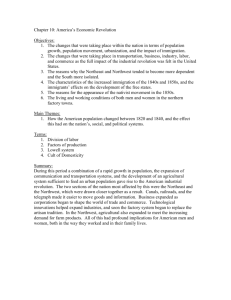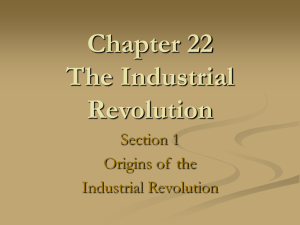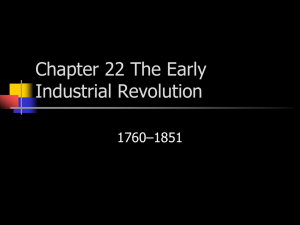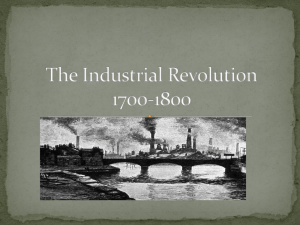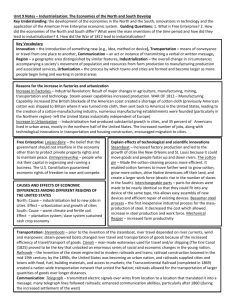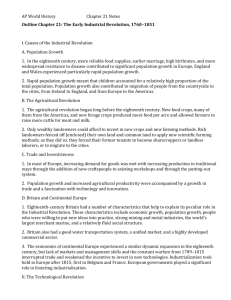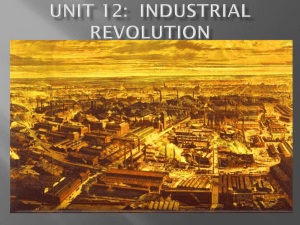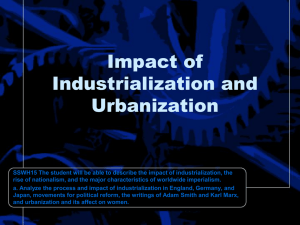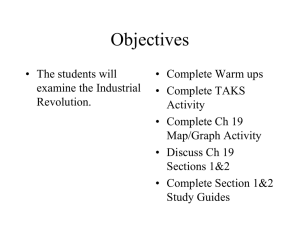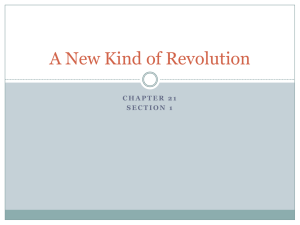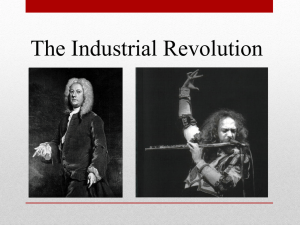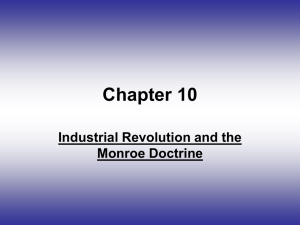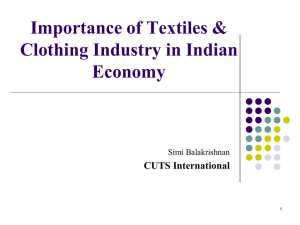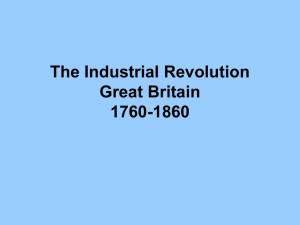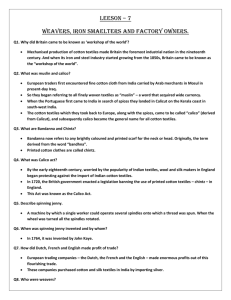Ch. 22 PPT - Moravia School District
advertisement
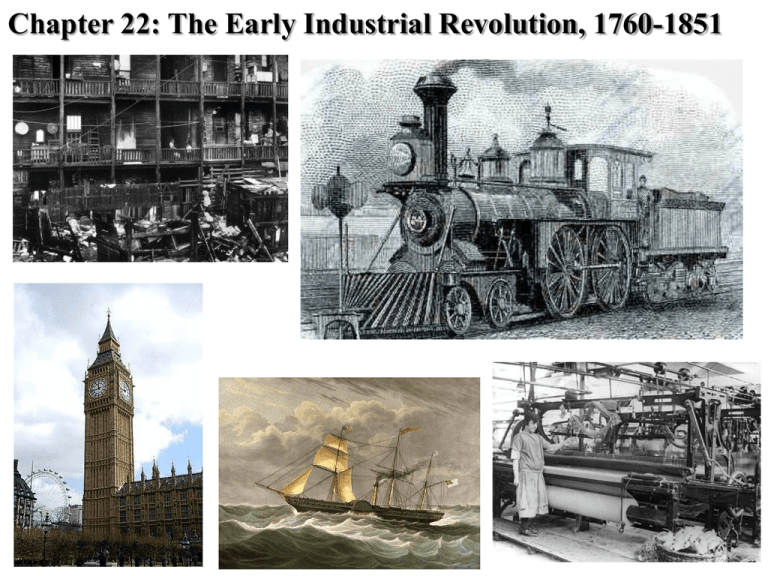
Chapter 22: The Early Industrial Revolution, 1760-1851 Causes of the Industrial Revolution Population Growth – Columbian exchange, younger marriages, more kids The Agricultural Revolution – new foods, new methods, new tools (all equal more food) Potatoes & Corn – more food per acre & feed for livestock Enclosure – consolidated and enclosed, tenant farmers looking for work; move to cities More workers than there are jobs Technology – increases efficiency, decreases need for human labor Britain & Continental Europe Rise of Industrialization in Britain – put inventions into practice more quickly than others British Advantages over Europe Fast flowing rivers Large amts iron ore and coal Natural harbors Large merchant fleet and navy 1789-1815 Revolutions & Wars (helped Britain to protect technologies) *Brits pass laws forbidding anyone who manufactures and/or repairs textiles machines to leave country w/o permission - Samuel Slater Causes of the Industrial Revolution… continued Rise of Industrialization in Europe Continental Europe attempts to follow Britain’s lead Encouraged private investors (joint-stock companies) Politics favorable to businesses Money to be made off increased trade Abundant coal & iron-ore throughout Europe Impetus for industrialization: Cottage Industry - mass production through division of labor (China – Song dynasty; iron prod – 11th century) New machines & mechanization Flying shuttle, Spinning Jenny, Water frame, Mule, etc Cotton gin – cotton prod and replaceable parts Why so important? Increase in the manufacture of iron (China – Song dynasty) 1) Machines, tools, etc 2) Steam Engine – more reliable consistent source of pwr - no longer confined to being near river 3) Electric telegraph http://inventors.about.com/od/indrevolution/ss/Industrial_Revo_5.htm Mass Production: Pottery – making identical items by breaking the process into simple tasks Wedgwood Pottery Increase in tea/coffee drinking – vessels that would not contaminate flavor Josiah Wedgewood imitated China’s porcelain Becomes member of the Royal Society Division of labor – increased productivity, lowered costs Used a steam engine in his factory (purchased from two other members of Royal Society) Mechanization: The Cotton Industry – application of machines to manufacturing Whitney’s Cotton Gin Innovations in Cotton Manufacturing Flying shuttle – greatly sped up weaving of threads to make textiles Spinning Jenny – greatly sped up spinning of cotton threads (downside was threads were soft and irregular; had to be used with linen – flax) Richard Arkwright: Water Frame (initially powered by water) – stronger thread Samuel Crompton: Mule – finer, more even thread British textiles able to compete successfully with high quality textiles (handmade) from India Inventions spurred on more mechanization 1) Increased manufacturer productivity 2) Lower prices for the consumer Luddites (1811-2) – backlash against technology (some serious machine bashing) Why were textiles a sure winner? Innovations in Iron Making Often assoc w/Deforestation (expensive & restricted) Darby’s coke – coal w/impurities removed = cheaper; albeit lower grade iron Darby’s grandson built a bridge of iron Crystal Palace – showcase greenhouse for 1851 Great Exhibition The Steam Engine The Newcomen and Watt Engines Newcomen – used to pump H2O out of mines Watt improves on it with condenser & allowed rotary motion Steamboats and ships US – a nation moved by steam (1st water, then land) 1838 – cross the Atlantic by steam Railroads – cheaper, faster, opens up travel 1829 – Liverpool to Manchester – Rocket approx 30 mph Railroads in America – opened up farm lands to markets Could now transport large amt of prod over land Railroads in Europe – satisfied need for transportation Communication over wires Electric Telegraph (1837) Samuel Morse – transmitted on a single wire Strung along railroads Increased speed of communication Impact of the early Industrial Revolution New Industrial cities – towns grew too fast (urbanization) sewage out the window, cheap/quick buildings, fire hazards, no bldg/safety codes Rural Environments North America - nature as an obstacle to be conquered Europe – population up, land scarce, woodlands denuded, national transportation networks Industry & Slavery – sugar/coffee/cotton demand = more slaves Working Conditions Unskilled, repetitive, unsafe Accidents frequent Phossy Jaw Women & Children in Industry Initially domestic servants or work @ home Women earned 1/3 to 2/3 less then men No family life, stress on marriage No time for childhood or school children 14-16 hours a day just like adults Workers had no rights No health/safety codes in factories No overtime, vacation time, holidays, etc (Typical work week 84-96 hr) Owners could use whatever means they deemed necessary to motivate workers Typically one 30-60 min break once a day Sometimes paid in scrip Changes in Society Handloom Weavers vs. Factory Workers Improvements and setbacks 1792-1815 – price of food rose faster than wages 1820’s – food prices fell, wages rose 1845-51 – Irish potato famine, min of ¼ died, ¼ left (reliance on lumbar – over 90% of crop destroyed) Irish eat potatos at every meal - more emigrate to America than any other country Worst famine in history (proportionally) English exploit famine “Irish Holocaust” The New Middle Class = beneficiaries, “nouveau riche” Middle-Class Women and middle-class attitudes “Cult of domesticity” – a woman's place is in the home Olympe de Gouges, The Declaration of the Rights of Woman (September 1791) http://chnm.gmu.edu/revolution/d/293/ 1792 – Mary Wollstonecraft “Vindication of the Rights of Women” English, argues for the rights of women to an education and opportunities equal to a man’s. 1848 – Resolutions passed at the Seneca Falls Conference to increase the rights of women. When do all women finally get the right to vote in England and America (after what major event)? http://etext.virginia.edu/t oc/modeng/public/WolVi nd.html Vindication of the Rights of Women New economic and political belief systems Laissez Faire Adam Smith Wealth of Nations – government - stay out of business (Laissez Faire) those seeking personal gain will promote general welfare by providing products that will benefit society. Prices will be determined by “Invisible Hand” of the market Invisible Hand - ? Promoted free-market capitalism, believed in private ownership Challenged mercantilism – (govt control) Other thinkers Thomas Malthus – population will out grow ability of agriculture to feed Believed war and famine were natural checks on population growth Humans should practice artificial population control (delay marriage, abstinence, etc) Jeremy Bentham – Utilitarianism (govt should look out for all citizens) Advocated for govt regulation of business and society Fredrich List (German) – argued for tariffs; disagreed with Laissez Faire trade Fledgingly industrial societies could not compete with Britiain (Zollverein) Positivism – scientific method applied to society, three stages of society Believed Sci Method could solve social problems Workers form communities under guidance of caring owners/businessmen Other unrealistic ideas included utopian socialism Sadler Commission – Commission to examine conditions during Ind Rev; focused mainly on issue of child labor Reform Bill 1832 – reforms to voting system; concentrated lessening corruption (most citizens were dissappointed with result – minimum income or property requirement still in place) Factory Act of 1833 – limits to child labor & working hours A young person (1318) no more than 12 hrs, and a child (9-13) no more than 9 hrs Mines Act of 1842 – no women or children (under 10) underground Corn Law tariffs repealed in 1846 http://www.spartacus.schoolnet.co.uk/IR1833.htm Workers Organizations – Chartism = universal male suffrage, secret ballots, pay for representatives, and annual elections. “Sun never set on the British Empire” Egypt – Britain took steps to ensure a weak Egypt – effectively killing Egyptian industrialization efforts (Suez Canal & Egyptian cotton) India – “Jewel in the Crown” of the British empire – discouraged domestic industry Opium Wars - Nemesis China – “Spheres of influence” – Western industrialized nations begin to divide China up Nemesis Letter to Queen Victoria British supplant India as world’s leading producer of textiles Sepoy Rebellion - Ethnocentrism http://www.victorianweb.org/history/empire/opiumwars/nemesis.htm



